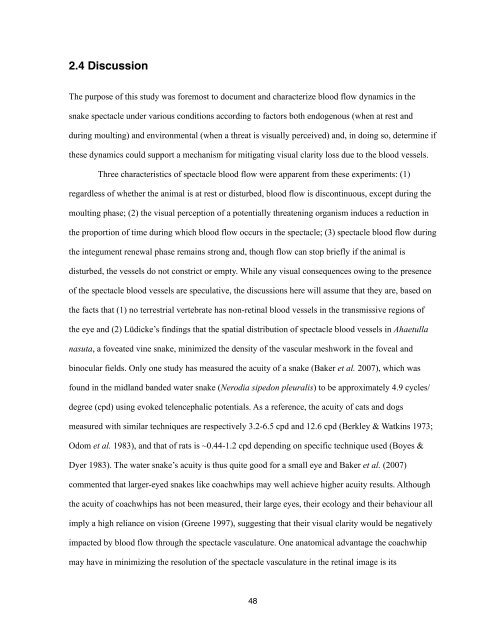Chapter 1, The Reptilian Spectacle - UWSpace - University of ...
Chapter 1, The Reptilian Spectacle - UWSpace - University of ...
Chapter 1, The Reptilian Spectacle - UWSpace - University of ...
You also want an ePaper? Increase the reach of your titles
YUMPU automatically turns print PDFs into web optimized ePapers that Google loves.
2.4 Discussion<br />
<strong>The</strong> purpose <strong>of</strong> this study was foremost to document and characterize blood flow dynamics in the<br />
snake spectacle under various conditions according to factors both endogenous (when at rest and<br />
during moulting) and environmental (when a threat is visually perceived) and, in doing so, determine if<br />
these dynamics could support a mechanism for mitigating visual clarity loss due to the blood vessels.<br />
Three characteristics <strong>of</strong> spectacle blood flow were apparent from these experiments: (1)<br />
regardless <strong>of</strong> whether the animal is at rest or disturbed, blood flow is discontinuous, except during the<br />
moulting phase; (2) the visual perception <strong>of</strong> a potentially threatening organism induces a reduction in<br />
the proportion <strong>of</strong> time during which blood flow occurs in the spectacle; (3) spectacle blood flow during<br />
the integument renewal phase remains strong and, though flow can stop briefly if the animal is<br />
disturbed, the vessels do not constrict or empty. While any visual consequences owing to the presence<br />
<strong>of</strong> the spectacle blood vessels are speculative, the discussions here will assume that they are, based on<br />
the facts that (1) no terrestrial vertebrate has non-retinal blood vessels in the transmissive regions <strong>of</strong><br />
the eye and (2) Lüdicke’s findings that the spatial distribution <strong>of</strong> spectacle blood vessels in Ahaetulla<br />
nasuta, a foveated vine snake, minimized the density <strong>of</strong> the vascular meshwork in the foveal and<br />
binocular fields. Only one study has measured the acuity <strong>of</strong> a snake (Baker et al. 2007), which was<br />
found in the midland banded water snake (Nerodia sipedon pleuralis) to be approximately 4.9 cycles/<br />
degree (cpd) using evoked telencephalic potentials. As a reference, the acuity <strong>of</strong> cats and dogs<br />
measured with similar techniques are respectively 3.2-6.5 cpd and 12.6 cpd (Berkley & Watkins 1973;<br />
Odom et al. 1983), and that <strong>of</strong> rats is ~0.44-1.2 cpd depending on specific technique used (Boyes &<br />
Dyer 1983). <strong>The</strong> water snake’s acuity is thus quite good for a small eye and Baker et al. (2007)<br />
commented that larger-eyed snakes like coachwhips may well achieve higher acuity results. Although<br />
the acuity <strong>of</strong> coachwhips has not been measured, their large eyes, their ecology and their behaviour all<br />
imply a high reliance on vision (Greene 1997), suggesting that their visual clarity would be negatively<br />
impacted by blood flow through the spectacle vasculature. One anatomical advantage the coachwhip<br />
may have in minimizing the resolution <strong>of</strong> the spectacle vasculature in the retinal image is its<br />
48
















